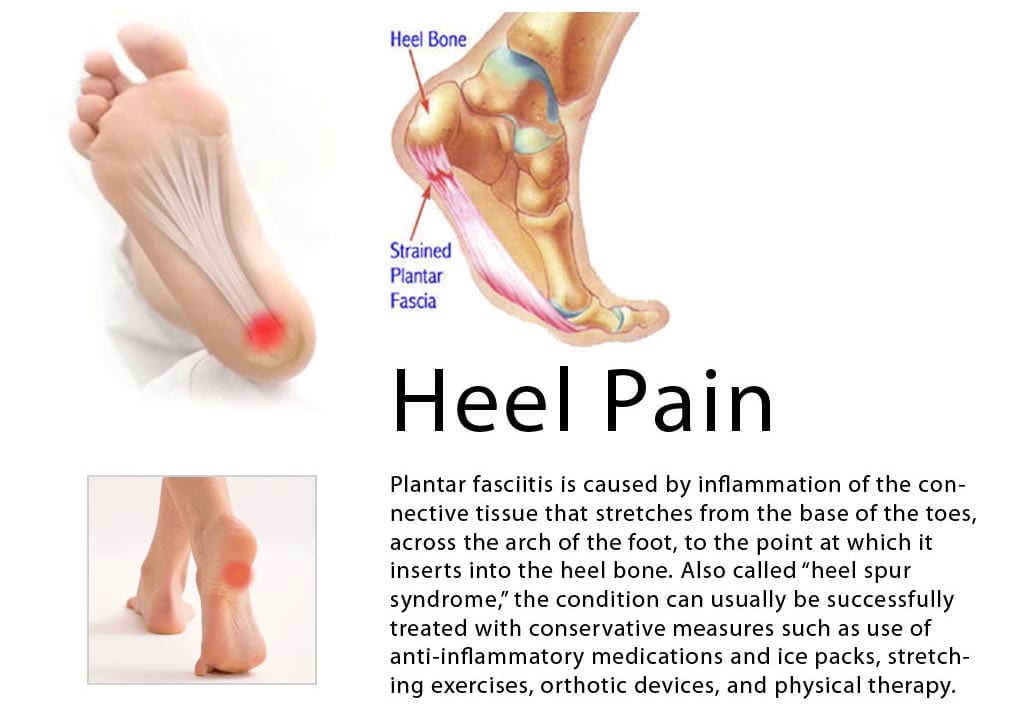What Is Heel Pain And The Best Ways To Cure It

Overview
Plantar fasciitis is a condition that causes heel and arch pain through inflammation on the bottom of the foot. The part that’s inflamed (swollen) is actually the plantar fascia, which is the connective tissue or ligament that stretches from the base of the toes, across the arch of the foot, and inserts into the heel bone. This painful condition can interfere with your daily activity and severely decrease your quality of life.
Causes
Plantar Fasciitis often leads to heel pain, heel spurs, and/or arch pain. The excessive stretching of the plantar fascia that leads to the inflammation and discomfort can be caused by the following: Over-pronation (flat feet) which results in the arch collapsing upon weight bearing A foot with an unusually high arch A sudden increase in physical activity Excessive weight on the foot, usually attributed to obesity or pregnancy Improperly fitting footwear Over-pronation (flat feet) is the leading cause of plantar fasciitis. Over-pronation occurs in the walking process, when a person's arch collapses upon weight bearing, causing the plantar fascia to be stretched away from the heel bone. With Plantar Fasciitis, the bottom of your foot usually hurts near the inside of the foot where the heel and arch meet. The pain is often acute either first thing in the morning or after a long rest, because while resting the plantar fascia contracts back to its original shape. As the day progresses and the plantar fascia continues to be stretched, the pain often subsides.
Symptoms
The main symptom of plantar fasciitis is heel pain when you walk. You may also feel pain when you stand and possibly even when you are resting. This pain typically occurs first thing in the morning after you get out of bed, when your foot is placed flat on the floor. The pain occurs because you are stretching the plantar fascia. The pain usually lessens with more walking, but you may have it again after periods of rest. You may feel no pain when you are sleeping because the position of your feet during rest allows the fascia to shorten and relax.
Diagnosis
Most cases of plantar fasciitis are diagnosed by a health care provider who listens carefully to your description of symptoms. During an examination of your feet, your health care provider will have to press on the bottom of your feet, the area most likely to be painful in plantar fasciitis. Because the pain of plantar fasciitis has unique characteristics, pain upon rising, improvement after walking for several minutes, pain produced by pressure applied in a specific location on your foot but not with pressure in other areas, your health care provider will probably feel comfortable making the diagnosis based on your symptoms and a physical examination. Your health care provider may suggest that you have an X-ray of your foot to verify that there is no stress fracture causing your pain.
Non Surgical Treatment
Shoe therapy, finding and wearing shoes that allow your feet to be in their natural position, is the most important treatment for plantar fasciosis. Shoes that possess a flat heel, are wide in the toe box, lack toe spring, and have flexible soles are most appropriate for this foot problem. An increasing number of shoe companies are producing shoes with these design characteristics, but shoes that include all these features are still difficult to find. For some suggested footwear models, see our clinic’s shoe list. Most conventional footwear can be modified by stretching the shoe’s upper, stretching out the toe spring, removing the shoe’s liner, and cutting the shoe at certain key points to allow more room for your foot. Visit your podiatrist to help you with these shoe modifications. Correct Toes is another helpful conservative treatment method for plantar fasciosis. Correct Toes addresses the root cause of your plantar fasciosis by properly aligning your big toe and reducing the tension created by your abductor hallucis longus on the blood vessels that feed and "cleanse" the tissues of your plantar fascia. Your plantar fasciosis-related pain will diminish when the dead tissue is washed away. A rehabilitation program, which includes targeted stretches and other exercises, for your foot may be helpful too. Dietary changes and aerobic exercise are particularly important for overweight individuals who have plantar fasciosis. Water aerobics may be most appropriate for those individuals whose pain does not allow them to walk or cycle. Physical therapy may be another helpful treatment modality for this problem, and includes ultrasound, electrical stimulation, contrast baths, and range-of-motion exercises. Massage, acupuncture, reflexology, and magnet therapy are holistic approaches that may be helpful.

Surgical Treatment
Although most patients with plantar fasciitis respond to non-surgical treatment, a small percentage of patients may require surgery. If, after several months of non-surgical treatment, you continue to have heel pain, surgery will be considered. Your foot and ankle surgeon will discuss the surgical options with you and determine which approach would be most beneficial for you. No matter what kind of treatment you undergo for plantar fasciitis, the underlying causes that led to this condition may remain. Therefore, you will need to continue with preventive measures. Wearing supportive shoes, stretching, and using custom orthotic devices are the mainstay of long-term treatment for plantar fasciitis.